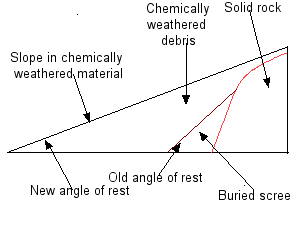Further flattening of a talus slope by chemical weathering and sliding to a lower angle of rest.Please start at Evolution.html In this case we start with a talus slope at the angle of rest of physically weathered fragments which are shown in yellow. The talus masks the bedrock which is shown in green. As time progresses chemical weathering may break the large fragments of weathered rock into smaller particles which are shown in blue. The layer of fine grained debris is no longer stable at the angle of rest of the coarser material. It begins to slide down the slope coming to rest at a new stable lower angle. This process eventually produces further physical and chemical weathering at the top of the slope. Sliding stops and the entire slope becomes stable when it is entirely at the angle of rest of the finer material. It is interesting to note that the fine chemically weathered debris covers up a steep slope in coarse material and a steep convex slope in the bedrock. If conditions changed and the weathered debris was eroded away steep convex sided hills would be formed. Processes like rain wash are discounted for this model of slope evolution. The end result of this type of slope evolution is shown in the diagram below.

|